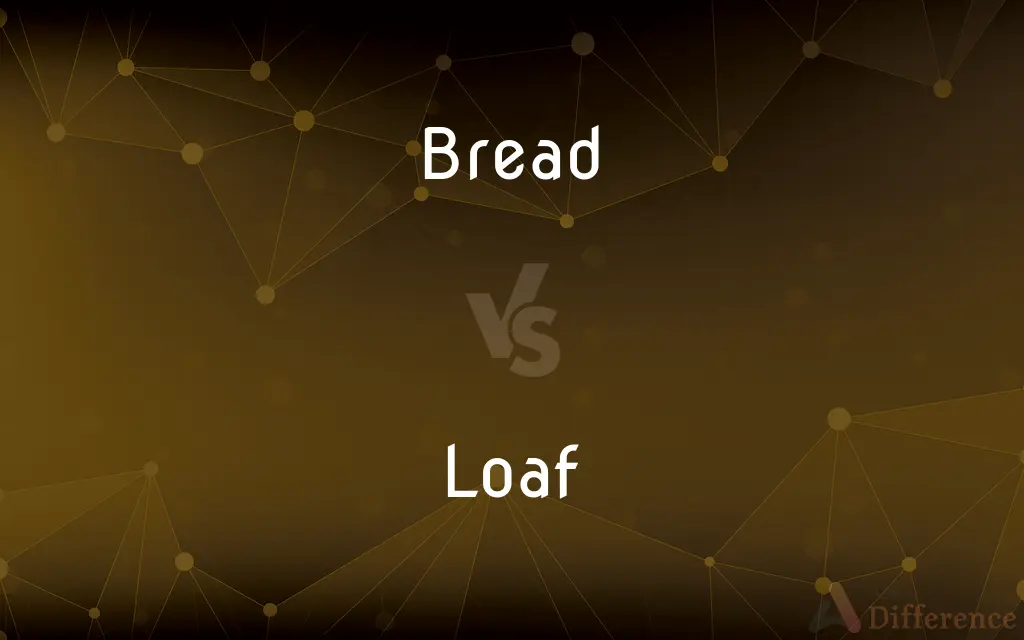Bread vs. Loaf — What's the Difference?
By Fiza Rafique & Maham Liaqat — Updated on March 11, 2024
Bread is a staple food made from flour and water, while a loaf refers to a quantity or shape of bread.

Difference Between Bread and Loaf
Table of Contents
ADVERTISEMENT
Key Differences
Bread encompasses a broad category of baked goods made primarily from flour, water, and often yeast or another leavening agent. It is a fundamental food item in many cultures worldwide, with countless variations in ingredients, textures, and flavors. A loaf, on the other hand, specifically refers to the shape or quantity of bread that is typically baked in a rectangular form and can be sliced. While all loaves are bread, not all bread takes the form of a loaf, as bread can also come in shapes like rolls, buns, or baguettes.
The term "bread" can be used to describe any product that falls under the category of bread, regardless of its shape, size, or type. This includes everything from sourdough and rye to flatbreads like tortillas and naan. Conversely, "loaf" is more specific, denoting a particular form or unit of bread. This specificity is useful in recipes or when purchasing bread, as it provides information about the bread's size and shape, which can affect how it is used or consumed.
Bread's versatility extends beyond its forms and shapes, encompassing various culinary uses, from sandwiches to toast to serving as a complement to meals. The loaf form, particularly useful for slicing, is favored for its convenience and suitability for a range of applications, including making sandwiches or toast. However, not all bread is best suited to this form; for example, flatbreads and rolls serve different purposes and are preferred for their particular characteristics in certain dishes.
The making of bread, regardless of its shape, involves a variety of baking techniques and ingredients that influence its texture, flavor, and nutritional content. Loaves, particularly, can vary in texture from dense and hearty to light and fluffy, depending on the ingredients and methods used. The crust of a loaf is also a distinguishing feature, with some preferring a thick, crunchy crust, while others might opt for a softer exterior.
Despite the distinctions, both bread and loaves share a common significance as essential elements of cuisine and culture. They represent not only sustenance but also the artistry and tradition of baking, reflecting the diversity of culinary practices around the world.
ADVERTISEMENT
Comparison Chart
Definition
A staple food made from flour and water, often including yeast or another leavening agent.
A quantity or shape of bread, typically rectangular and suitable for slicing.
Varieties
Includes various types like sourdough, rye, flatbreads, rolls, and baguettes.
Specifically refers to the shape or unit of bread, not the type.
Usage
Can be used in a wide range of culinary applications, from sandwiches to complementing meals.
Often used for slicing, making it ideal for sandwiches and toast.
Characteristics
Can vary widely in texture, flavor, and ingredients.
Typically known for its rectangular shape and versatility in slicing.
Cultural Significance
Represents a fundamental element in many cultures’ cuisines, with diverse traditions and recipes.
Specific form that reflects baking practices and preferences in various cultures.
Compare with Definitions
Bread
Reflects the artistry and tradition of baking across the world.
Artisan bread makers often experiment with ancient grains for unique flavors.
Loaf
A quantity or shape of bread, typically baked in a rectangular form.
A loaf of sourdough bread was cooling on the rack.
Bread
A fundamental food prepared by baking a dough of flour and water.
Freshly baked bread fills the kitchen with a comforting aroma.
Loaf
Can vary in texture from light and airy to dense and hearty.
The whole wheat loaf had a dense, satisfying texture.
Bread
A versatile food item, used for sandwiches, toast, or as a side.
Garlic bread is a popular side dish with pasta.
Loaf
Designed for convenience in slicing, ideal for sandwiches or toast.
He sliced the loaf thinly for breakfast toast.
Bread
Can include a variety of ingredients and leavening agents for different textures and flavors.
Whole grain bread is packed with nutrients and has a hearty texture.
Loaf
Often features a distinctive crust, which can be soft or crunchy.
The crust of the loaf was perfectly golden and crunchy.
Bread
Served in various forms across cultures, from flatbreads to rolls.
In India, naan bread is a delicious accompaniment to curries.
Loaf
Represents a common form in many baking traditions, suitable for everyday use.
A fresh loaf of bread is a staple in many households.
Bread
Bread is a staple food prepared from a dough of flour and water, usually by baking. Throughout recorded history, it has been a prominent food in large parts of the world.
Loaf
A loaf is a, usually rounded or oblong, mass of food, typically and originally of bread. It is common to bake bread in a rectangular bread pan, also called a loaf pan, because some kinds of bread dough tend to collapse and spread out during the cooking process.
Bread
A staple food made from flour or meal mixed with other dry and liquid ingredients, usually combined with a leavening agent, and kneaded, shaped into loaves, and baked.
Loaf
A shaped mass of bread baked in one piece.
Bread
Food in general, regarded as necessary for sustaining life
"If bread is the first necessity of life, recreation is a close second" (Edward Bellamy).
Loaf
A shaped, usually rounded or oblong, mass of food
Veal loaf.
Bread
Something that nourishes; sustenance
"My bread shall be the anguish of my mind" (Edmund Spenser).
Loaf
To pass time at leisure; idle.
Bread
Means of support; livelihood
Earn one's bread.
Loaf
(also loaf of bread) A block of bread after baking.
Bread
(Slang) Money.
Loaf
Any solid block of food, such as meat or sugar.
Bread
To coat with bread crumbs, as before cooking
Breaded the fish fillets.
Loaf
(Cockney rhyming slang) The brain or the head (mainly in the phrase use one's loaf).
Bread
(uncountable)
Loaf
A solid block of soap, from which standard bar soap is cut.
Bread
A foodstuff made by baking dough made from cereals.
We made sandwiches with the bread we bought from the bakery.
Any leftover bread can be put into the pudding.
Loaf
(Cockney rhyming slang) To headbutt
Bread
Food; sustenance; support of life, in general.
Loaf
(Internet slang) To be in catloaf position (for cats or other animals)
Bread
(countable) Any variety of bread.
Loaf
(intransitive) To do nothing, to be idle.
Bread
Money.
Loaf
Any thick lump, mass, or cake; especially, a large regularly shaped or molded mass, as of bread, sugar, or cake.
Bread
Breadth.
Loaf
To spend time in idleness; to lounge or loiter about.
Bread
A piece of embroidery; a braid.
Loaf
To spend in idleness; - with away; as, to loaf time away.
Bread
(transitive) To coat with breadcrumbs.
Breaded fish
Loaf
A shaped mass of baked bread
Bread
To make broad; spread.
Loaf
Be lazy or idle;
Her son is just bumming around all day
Bread
(transitive) To form in meshes; net.
Loaf
Be about;
The high school students like to loiter in the Central Square
Who is this man that is hanging around the department?
Bread
To spread.
Bread
To cover with bread crumbs, preparatory to cooking; as, breaded cutlets.
Bread
An article of food made from flour or meal by moistening, kneading, and baking.
Bread
Food; sustenance; support of life, in general.
Give us this day our daily bread.
Bread
Food made from dough of flour or meal and usually raised with yeast or baking powder and then baked
Bread
Informal terms for money
Bread
Cover with bread crumbs;
Bread the pork chops before frying them
Common Curiosities
Is a loaf always made from white flour?
No, loaves can be made from various types of flour, including whole wheat, rye, and multigrain, affecting their flavor and nutritional content.
Why is bread important in many cultures?
Bread is a staple food in many cultures due to its versatility, nutritional value, and the wide variety of forms and flavors it can take, reflecting culinary traditions and practices.
How does the leavening agent affect bread and loaves?
The leavening agent, such as yeast or baking powder, influences the texture and rise of the bread or loaf, contributing to its lightness or denseness.
What makes a loaf different from other forms of bread?
A loaf refers to a specific shape or quantity of bread, often rectangular and suitable for slicing, whereas bread can come in many forms, including rolls, buns, and flatbreads.
How do ingredients affect the texture of a loaf?
The ingredients, along with the kneading and baking processes, influence the loaf's texture, which can range from light and fluffy to dense and hearty.
Can I make a loaf of bread without a loaf pan?
While a loaf pan helps achieve the classic loaf shape, bread can be shaped and baked without one, though the final shape may differ.
Can any type of bread be made into a loaf?
While many types of bread can be baked in loaf form, some, like flatbreads, are traditionally prepared in distinct shapes and may not be suited to the loaf form.
How long can a loaf of bread last before it goes stale?
The shelf life of a loaf of bread varies depending on ingredients and storage, but it generally lasts several days before becoming stale. Proper storage can extend its freshness.
Are there gluten-free bread and loaves?
Yes, gluten-free versions of bread and loaves are available, made from alternative flours like rice, almond, or coconut flour.
Can bread or loaves be frozen for later use?
Yes, both bread and loaves can be frozen to preserve freshness for later use. It's best to slice loaves before freezing for convenience.
Share Your Discovery

Previous Comparison
Jetty vs. Wharf
Next Comparison
Common vs. NeuterAuthor Spotlight
Written by
Fiza RafiqueFiza Rafique is a skilled content writer at AskDifference.com, where she meticulously refines and enhances written pieces. Drawing from her vast editorial expertise, Fiza ensures clarity, accuracy, and precision in every article. Passionate about language, she continually seeks to elevate the quality of content for readers worldwide.
Co-written by
Maham Liaqat














































